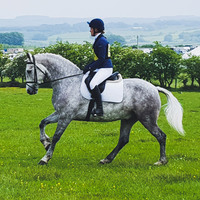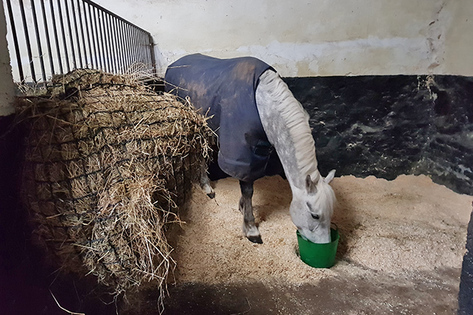
Are You & Your Horse Ready For Bitting Advice? The Steps You Need To Consider First
Equestrian Advice & Guides All Disciplines
Build your business profile for FREE and expose your services to thousands of potential clients!
Create my profile now!
With winter looming and many horses’ routines changing, either switching from being out to in, or generally spending more time indoors, you might be thinking about moving to their winter feed routine. While nutrition is too vast and complex a subject to fully cover here, hopefully this article might help to give you a few pointers to consider.
This should be based on the weight of the animal with an aim of feeding between 2.5% and 3% of their body weight per day. The most accurate way of weighing them is by using an equine weighbridge but realistically, who has one of those hidden away? If you have an equine weight tape, that’s a great, simple tool to use; while not always completely accurate, they give a good approximation, which can be useful if you’re monitoring for differences (e.g. weight loss or weight gain).

If you don’t have a weight tape, you can get a fairly accurate weight using an everyday measuring tape and a simple formula, which has been shown to be accurate within +/- 50 pounds (22.6kg):
For example, using this method, Rock is 196cm round his girth and 154cm in length, so it works out that he weighs approximately 497kg – which for a 15.2hh, broad rib caged Connemara is probably fairly accurate.
Once you have their weight the other factors to consider are:
Per feed, it’s also important to consider the total weight of feed. Try not to exceed 3.5 - 4 lbs (1.5 - 2kg) per feed for a horse, including all chaff and sugar beet, or 3 – 3.5 lbs (1.25 – 1.5kg) for a pony, as this prevents overloading their digestive system and helps towards optimum digestion.
Changing your horse’s diet should be done extremely gradually to avoid hind gut disruption and the risk of colic, which is partly why autumn can see an increase in colic cases – the recommendation is a lot longer than most people think. It’s recommended to adjust over 3 weeks (or 2 weeks as an absolute minimum).
Week 1 would be 75% of the old diet and 25% of the new diet
Week 2 would be 50% old diet and 50% new diet
Week 3 would be 25% old diet and 75% new diet
This includes switching from summer grazing to hay/haylage and also moving from hay to haylage.
As a rule, it’s recommended that equine diets should be higher in fibre and fat and Digestible energy (DE) should be considered in your diet proportions eg the approximate amount of forage versus the concentrate (hard) feed.
 There are 4 dietary components to consider;
There are 4 dietary components to consider;Water
Water is the most important nutrient and should always be readily available. Horses will drink an average of 8 - 12 gallons (30 - 45 litres) per day (!) but other factors affect this, such as the weather, exercise and dry mater intake (e.g. hay rather than grass). Make sure your horse always has access to clean, fresh water.
Forage
Forage is higher in fibre, which is fermented in the hind gut, and lower in energy than concentrates. Hind gut fermentation generates heat, helping them to keep warm and maintain body weight. It provides slow release energy and should be the main part of your horse’s diet. Forage includes grass, alfalfa, hay, haylage, chaff, straw and sugar beet.
Forage should make up at least half their daily food intake as it’s vital to keep their digestive system functioning and is the single most important feed component, aside from water. Feeding a diet more weighted towards fibre aids in preventing colic, dehydration and gastric ulcers, as well as helping to meet their psychological needs. When the fibre is fermented in the hindgut, it also provides important vitamins like B1, biotin and vitamin K.
The absolute minimum forage requirement is 1% of their body weight per day and a maintenance diet is approximately 2.5% of their body weight per day. For example, if you had a 1000lb or 450kg horse, a 2.5% maintenance diet of forage would be 24lbs or 11kg per day.
 But all forage is not created equal in terms of energy, nutrients and protein. For example, alfalfa hay that’s cut early in maturity is high in nutrients (calcium and protein rich) and typically higher in energy than other hays, such as timothy. Haylage generally has a higher digestible energy level than hay but it also has a higher water content, so due to being wrapped for storage, the nutrient and fibre levels can be “diluted”. Hay harvested in May and June is likely to have a higher nutritional value than that cut in July or August.
But all forage is not created equal in terms of energy, nutrients and protein. For example, alfalfa hay that’s cut early in maturity is high in nutrients (calcium and protein rich) and typically higher in energy than other hays, such as timothy. Haylage generally has a higher digestible energy level than hay but it also has a higher water content, so due to being wrapped for storage, the nutrient and fibre levels can be “diluted”. Hay harvested in May and June is likely to have a higher nutritional value than that cut in July or August.
For more information on hay and haylage, see 'The Difference Between Hay And Haylage... Explained'.
Beet pulp or sugar beet is a low sugar by-product and is a forage alternative that can be used to supplement fibre needs. It comes with and without molasses, which should be considered if you have a good doer or a sugar sensitive horse.
Lots of horses at rest, in light or even medium work can have a fully forage diet, but you might like to also consider a balancer to ensure they get all the essential vitamins and minerals.
Concentrates
Concentrates are higher in energy and lower in fibre than forage, and may be required if your horse is worked harder and needs more energy than a forage only diet can provide. There are several different types of concentrate, such as corn, oats, barley, maize, soybean meal, etc. As they contain increased levels of crude protein (CP), they are higher in energy. Generally these concentrates are fed as pre-mixed feeds but they are available as “straights” too. How much you feed is an import factor in colic prevention, so their diet should be fibre based and you should feed as little concentrate as possible. If too much concentrate is fed at one time, the small intestine won’t digest it all and it will be passed through too quickly to the cecum, where the microbes will go crazy and the pH levels will be upset and become more acidic.
Supplements
Supplements include trace minerals, vitamins and fat. Generally, levels of trace minerals (copper, zinc, manganese and selenium) are sufficient in premixed concentrate feeds and can also be met with forage, unless your soil is particularly mineral deficient. When it comes to vitamins, vitamin A comes from forage, vitamin D from sunshine and vitamin B is produced in the hind gut. In addition, there’s also vitamin C and E, which may be needed more by very athletic horses. Fats are an excellent source of calories for either weight gain or energy increase and can be fed at up to 10% of the total diet; so if the diet calls for 30lbs or 13.5kg, 3lbs or 1.3kg of it can be fat. Linseed, flax, corn, vegetable and sunflower oils are the most common types of fat.
There's no doubt that equine nutrition can be a mind-boggling subject as there’s so much to consider, but to summarize;
The author of this article, Caroline Ramsay, holds an Equine Nutrition Award by The University of Edinburgh, covering feed composition (and how this affects digestibility), nutrient sources, dietary management, general nutrient requirements of horses and ponies, body condition score and clinical nutrition.
For more advice from Caroline, see her Horsemart Author Page or you can keep up to date with all her adventures with her Connemara, Rock, by following them on Facebook or Instagram @grey_connieadventures.

